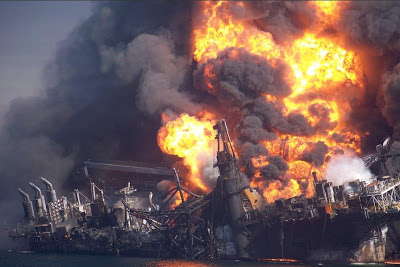BP / Deepwater Horizon Oil & Gas Disaster – What’s Changed?

The Deepwater Horizon’s final hours, April 22, 2010. Photo courtesy New York Times. More here.
One year ago today, after an explosion and fire that killed 11 workers and injured 17 others, a technological marvel — the Deepwater Horizon semisubmersible drill rig — slipped beneath the waves and sank in 5,000′ of water, 40 miles offshore in the deep Gulf of Mexico. The rig had drifted and burned out of control for nearly two days following the catastrophic blowout of BP’s ill-fated oil and gas well, named Macondo, that triggered the blast at 10pm on April 20.

Oil-burning operations in the Gulf, June 2010. Photo courtesy FSU / Dr. Oscar Garcia-Pineda
We didn’t know it at the time, but this was the start of what would become the world’s worst accidental oil spill. Before the well was finally brought under control and capped on July 15, it had gushed 172 million gallons of crude oil, and billions of cubic feet of natural gas, into the cold, dark waters at the bottom of the sea.The Gulf’s resiliency has proven some of the gloomiest of doom-sayers wrong; this is a naturally “oily” ecosystem, with hundreds of known natural oil and gas seeps in deep water, and a microbial defense system that reminds me of the white blood cells in our own immune systems. The Gulf hasn’t died, but it almost certainly has changed; the jury is still out on the short- and long-term environmental damage this spill has wrought. Independent scientists and those involved in the official Natural Resources Damage Assessment process suggest it may be years before the full account can be written.
Likewise, the full impact of the spill on other culturally and economically important industries in the Gulf region and beyond, like seafood and hospitality, may take a few years to understand. So will the human health effects of the spill.
Meanwhile BP itself is once again booking strong profits, moving forward with ambitious new drilling plans, and appears to be thriving. Polls show the public strongly favors more offshore drilling. The federal government is issuing new permits to drill in deep water, based largely on their faith in two new well-containment devices that would take weeks to assemble and deploy in the next emergency, allowing tens of millions of gallons to hit the water before these untested devices even arrive on the scene. I’d like to say we’ve got totally retooled oil spill cleanup plans and capabilities to deal with the inevitable next spill, but sadly that is not the case. Apparently the industry and our government have decided this is good enough for the people of the Gulf:

Cleanup workers wiping oil from marsh grass. U.S. Coast Guard Photo by Petty Officer 3rd Class Derek W. Richburg.
As time goes by it’s looking less likely that the well-researched recommendations of the National Oil Spill Commission are going to be implemented, meaning offshore drilling will continue to be a high-risk activity. Why is this? I’ll turn it over now to a couple of writers who sum it up far more eloquently than I could. David Jenkins of Republicans for Environmental Protection blasts the inaction by Congress in the wake of this historic disaster in The Spill Washington Forgot. And Carl Cannon puts the politics and policy in context in this compelling analysis, Political Partisanship and Earth Day.Now for the good news: We’ve made real progress here at SkyTruth, forming a space-water- air SWAT team with SouthWings and Waterkeeper Alliance. The Gulf Monitoring Consortium leverages the skills and expertise of our organizations to help us efficiently and effectively evaluate, investigate and document oil pollution incidents in the Gulf of Mexico. We’ll keep you updated as the Consortium grows, builds new information tools, responds to future incidents, and publishes our findings.


